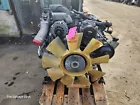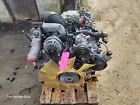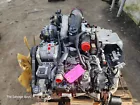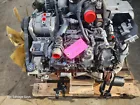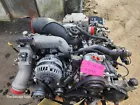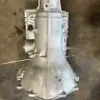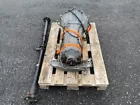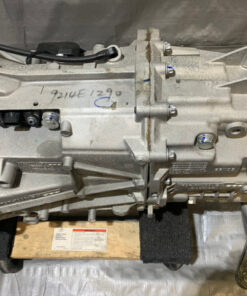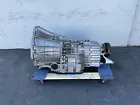GM CHEVROLET 6.6 LBZ DURAMAX ENGINE
3,410 $ Original price was: 3,410 $.3,360 $Current price is: 3,360 $.
GM Chevrolet 6.6L LBZ Duramax Engine: A Deep Dive
The GM Chevrolet 6.6L LBZ Duramax Engine is widely regarded as one of the best diesel engines ever made for heavy-duty trucks. This powerhouse engine was introduced in the mid-2000s and quickly gained a loyal following for its exceptional durability, power, and clean operation compared to other diesel engines of its era.
GM Chevrolet 6.6L LBZ Duramax Engine: A Deep Dive
The GM Chevrolet 6.6L LBZ Duramax Engine is widely regarded as one of the best diesel engines ever made for heavy-duty trucks. This powerhouse engine was introduced in the mid-2000s and quickly gained a loyal following for its exceptional durability, power, and clean operation compared to other diesel engines of its era.
History and Development
The GM Chevrolet 6.6L LBZ Duramax Engine is part of the larger Duramax family, which started with the LB7 in 2001. The GM Chevrolet 6.6L LBZ Duramax Engine was introduced for the 2006 model year as the third iteration of the Duramax line, replacing the LB7 and preceding the LMM. GM worked closely with Isuzu to design these engines, leveraging Isuzu’s expertise in diesel technology combined with GM’s truck engineering.
The GM Chevrolet 6.6L LBZ Duramax Engine was only produced for two model years, 2006 and 2007. Despite this short production run, the GM Chevrolet 6.6L LBZ Duramax Engine developed a legendary reputation for reliability and performance that many owners still seek today.
Engine Specifications and Design
The GM Chevrolet 6.6L LBZ Duramax Engine with the following key specs:
-
Displacement: 6.6 liters (approximately 401 cubic inches)
-
Configuration: 90-degree V8
-
Bore x Stroke: 4.06 x 3.89 inches
-
Compression Ratio: 16.8:1
-
Fuel System: Common rail direct injection with Bosch CP4 injection pump
-
Turbocharger: Variable Geometry Turbocharger (VGT)
-
Power Output: 350 horsepower at 3,000 rpm
-
Torque: 650 lb-ft at 1,600 rpm
The GM Chevrolet 6.6L LBZ Duramax Engine uses a sophisticated high-pressure common rail system to deliver precise fuel metering, improving both power and emissions control. This engine features a variable geometry turbocharger which adjusts the turbo’s vane angles to optimize boost pressure across a wide RPM range, delivering excellent low-end torque and efficient high-end power.
The block is made of cast iron for durability, and the cylinder heads are aluminum to save weight. The engine uses overhead valves (OHV) with two valves per cylinder, and it runs on a 24-valve setup total.
Emissions and Clean Operation
One of the most praised aspects of the LBZ Duramax is its emissions profile. The LBZ was the first Duramax engine to meet the EPA 2007 emissions standards without requiring a Diesel Particulate Filter (DPF) or Selective Catalytic Reduction (SCR) system. Instead, it uses:
-
A diesel oxidation catalyst (DOC)
-
An exhaust gas recirculation (EGR) cooler
-
A variable geometry turbocharger that helps reduce particulate emissions
This design made the GM Chevrolet 6.6L LBZ Duramax Engine cleaner and simpler to maintain compared to its successor, the LMM, which introduced more complicated emissions controls like DPF and DEF (diesel exhaust fluid).
Applications
The GM Chevrolet 6.6L LBZ Duramax Engine was primarily used in:
-
Chevrolet Silverado 2500HD and 3500HD
-
GMC Sierra 2500HD and 3500HD
These trucks were often used for heavy-duty towing, hauling, and commercial work. The LBZ’s combination of strong torque and good fuel economy made it very popular with truck owners who needed serious capability without sacrificing reliability.
Strengths and Reliability
The GM Chevrolet 6.6L LBZ Duramax Engine is renowned for its reliability and durability. Many LBZ engines have been known to run well over 300,000 miles with proper maintenance. Here are some of the key strengths:
-
Durable Engine Block: The cast-iron block is robust and resists wear even under heavy loads.
-
Strong Bottom End: The crankshaft, rods, and pistons are designed to handle high torque output.
-
Fewer Emissions Issues: The simpler emissions setup means fewer sensors, less chance of component failure, and easier maintenance.
-
Solid Aftermarket Support: The LBZ has a large enthusiast community, with a wide range of parts and upgrade options.
-
Good Fuel Economy for Its Power: Owners report respectable mileage for a heavy-duty diesel, especially when towing.
Common Issues
While the GM Chevrolet 6.6L LBZ Duramax Engine is highly regarded, no engine is perfect. Here are some common issues that LBZ owners might encounter:
-
Injector Problems: Over time, fuel injectors can wear out or fail, leading to rough running or misfires. Replacing injectors every 150,000 to 200,000 miles can prevent major problems.
-
CP4 Injection Pump Failures: The CP4 high-pressure fuel pump can be a weak point. Failures can lead to fuel starvation and catastrophic damage if not addressed. Regular fuel filter changes and clean fuel help mitigate this risk.
-
EGR Cooler Leaks: The EGR cooler can develop leaks, which may cause coolant to enter the intake system and result in white smoke or overheating. Early detection is key.
-
Glow Plug Wear: Glow plugs wear out over time, leading to cold start issues. Replacing them is a routine maintenance item.
-
Turbocharger Wear: While robust, the VGT turbo can eventually wear out, especially if oil changes are neglected. Watch for boost loss or strange noises.
Maintenance Tips
Proper maintenance is crucial for the longevity of any diesel engine, especially one as powerful as the LBZ Duramax. Here are some tips to keep it running strong:
-
Regular Oil Changes: Use high-quality synthetic diesel engine oil and change it every 5,000 to 7,500 miles, depending on use.
-
Fuel Filter Replacement: Replace the fuel filter every 15,000 to 20,000 miles to protect injectors and the CP4 pump.
-
Coolant Flush: Change coolant every 2 to 3 years to avoid corrosion and maintain EGR cooler health.
-
Check for Leaks: Regularly inspect for coolant, oil, or fuel leaks.
-
Air Filter Replacement: Change air filters regularly to maintain airflow and protect the turbo.
-
Monitor for Codes: Use a scan tool to check for diagnostic trouble codes (DTCs) related to fuel or emissions systems.
-
Turbo Inspection: Pay attention to boost pressure and turbo noise; replace if needed.
Performance Upgrades
The GM Chevrolet 6.6L LBZ Duramax Engine is a favorite among diesel performance enthusiasts due to its solid stock foundation and tuning potential. Some popular upgrades include:
-
Aftermarket Tuners: Programmers such as those from Bully Dog or EFI Live can increase power and torque by adjusting fuel maps, turbo boost, and timing.
-
Upgraded Injectors: High-flow injectors can provide more fuel for increased horsepower.
-
Cold Air Intakes: Improve airflow and throttle response.
-
Performance Exhaust: Free-flowing exhaust systems reduce backpressure and increase power.
-
Intercooler Upgrades: Better intercooling improves air density and engine efficiency.
-
Upgraded Turbochargers: Some owners swap the stock VGT turbo for larger or hybrid turbos for extreme power gains.
-
Transmission Tuners: Optimizing shift points and torque limits in the Allison transmission improves drivability under load.
Why GM Chevrolet 6.6L LBZ Duramax Engine Still Matters
Even though the GM Chevrolet 6.6L LBZ Duramax Engine was produced for only two years, it’s often regarded as the best “classic” Duramax engine. It strikes a balance between:
-
Power and torque
-
Simplicity and emissions compliance
-
Durability and upgrade potential
Truck owners who want a reliable, easy-to-maintain diesel with solid power often seek out LBZ-equipped trucks. The GM Chevrolet 6.6L LBZ Duramax Engine also serves as a benchmark for diesel performance tuning and durability in the aftermarket world.
Summary
The GM Chevrolet 6.6L LBZ Duramax engine is a remarkable diesel powerplant that combines strong performance, clean emissions, and long-term reliability. Produced from 2006 to 2007, it remains a sought-after engine for heavy-duty trucks and diesel enthusiasts alike.
Key highlights include:
-
350 hp and 650 lb-ft torque output
-
Advanced common rail fuel system with Bosch CP4 pump
-
Variable Geometry Turbocharger for efficient boost control
-
Clean emissions design without the complexity of DPF or SCR
-
Legendary durability and strong aftermarket support
Whether you use your GM Chevrolet 6.6L LBZ Duramax Engine-powered truck for towing, work, or performance, this engine offers an excellent balance of power and reliability that’s tough to beat.
Related products
Transmissions
Transmissions
Transmissions
Transmissions
Transmissions
Transmissions
Transmissions


